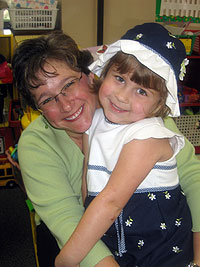 Dr. Kristin Davis knows all about the importance of healthy vision and hearing in children. After all, she is a pediatrician. However, it wasn't until a screening by the Sight & Hearing Association (SHA) when it hit closer to home. Her daughter, Kaitlyn, then age three, had a hearing loss - and Kristin didn't know it. According to Kristin, Kaitlyn's speech and vocabulary were great and she did not suffer from recurring ear infections - both signs of a potential hearing problem.
Dr. Kristin Davis knows all about the importance of healthy vision and hearing in children. After all, she is a pediatrician. However, it wasn't until a screening by the Sight & Hearing Association (SHA) when it hit closer to home. Her daughter, Kaitlyn, then age three, had a hearing loss - and Kristin didn't know it. According to Kristin, Kaitlyn's speech and vocabulary were great and she did not suffer from recurring ear infections - both signs of a potential hearing problem.
"Timing was perfect for Kaitlyn," Kristin said. "Had she not had the screenings early, we would not have known she couldn't hear, and there are so many other issues that can arise out of that."
Kaitlyn was screened twice by SHA at her preschool, Noah's Ark Preschool in Circle Pines. After her first screening indicated she didn't pass the hearing tests, Kristin's reaction was "whoa … this is something." A rescreen one month later indicated another failed test and that Kaitlyn should see a doctor.
Kristin took her to see Dr. Barbara Malone, a pediatric ENT (ear-nose-throat doctor), who diagnosed her with a conductive hearing loss. A conductive hearing loss occurs because of a mechanical problem in the middle or inner ear. For instance, the eardrum may fail to vibrate in response to sound. Even fluid trapped in the middle ear can cause a conductive hearing loss.
That was the case for Kaitlyn. Her eustachian tube, which drains fluid from the middle ear, was blocked by tissue surrounding her adenoids and tonsils, resulting in chronic fluid in her middle ear. "Her doctor covered my ears with her hands and said, 'This is how Kaitlyn hears,'" explained Kristin. "I felt just horrible, but I had no way of knowing."
Fortunately, a conductive hearing loss is usually reversible. Kaitlyn underwent surgery to remove her adenoids and tonsils. Almost immediately, everything was much more clear and pronounced. "I was blow-drying her hair," recalled Kristin, "and she covered her ears because it was too loud." Other things like that - running water in the bathtub, the flushing of toilets in a public restroom, and even a movie - were all loud sounds that made Kaitlyn quickly cover her ears. Kristin then realized how much Kaitlyn had been missing.
"She didn't have a delay, and she had been to all of her well-visits" she said, "so we didn't have any concerns. But we didn't know she couldn't hear." Kaitlyn was so excited about her newfound hearing that she colored a picture for Dr. Malone with the words: "Thank you for helping me hear." Now, when Kristin meets a patient with an ear infection or fluid in the ears, she is vigilant to get it cleared up. "A huge part of my quickness to act is because I've seen it up close and firsthand."
"In a pediatric office, we very rarely rely on a three-year well-check hearing screening," Kristin said. "Too often the child doesn't want to participate or they may not understand what they're supposed to do.”But getting a thorough screening, [like the one by Sight & Hearing Association], is absolutely important for language development and articulation," explained Kristin. "Significant development and behavior issues, even issues with potty training, can occur because of the mere fact that a child can't communicate." Kristin says Kaitlyn was a perfect candidate for this screening.